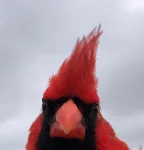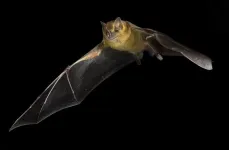(Press-News.org) PULLMAN, Wash. – The bright lights of big cities could be causing an evolutionary adaptation for smaller eyes in some birds, a new study indicates.
Researchers found that two common songbirds, the Northern Cardinal and Carolina Wren, that live year-round in the urban core of San Antonio, Texas, had eyes about 5% smaller than members of the same species from the less bright outskirts. Researchers found no eye-size difference for two species of migratory birds, the Painted Bunting and White-eyed Vireo, no matter which part of the city they lived in for most of the year.
The findings, published in Global Change Biology, have implications for conservation efforts amid the rapid decline of bird populations across the U.S.
"This study shows that residential birds may adapt over time to urban areas, but migratory birds are not adapting, probably because where they spend the winter--they are less likely to have the same human-caused light and noise pressures. It may make it more difficult for them to adjust to city life during the breeding season,” said Jennifer Phillips, a Washington State University wildlife ecologist and senior author.
The U.S. and Canada have lost 29% of their bird populations or 3 billion birds since 1970, according to previous research. Scientists believe that habitat fragmentation is the primary driver of the decline in birds, but the current study suggests that sensory pollutants like human-caused light may also play a role in the birds’ ability to cope with city life.
For this study, Phillips worked with post-doctoral fellow Todd Jones and graduate student Alfredo Llamas of Texas A&M University, San Antonio, to study more than 500 birds from central and edge areas of San Antonio. They compared body and eye sizes of the birds and analyzed noise and light measurements during the day and night of each area.
There was no difference among the body sizes of birds in different areas, except for one species: the Painted Bunting. Upon further analysis, the researchers found that this size difference was mostly due to age. Younger, smaller male buntings, who cannot compete as well for mates as their more colorful elders, were more often found in the brighter, noisier central locations, which are likely less desirable.
While other studies have looked at how urban light affects the timing of birds’ “dawn song” and circadian rhythms, this is the first-known study to show a connection to eye size.
The smaller eye size may enable birds to deal with the brighter and more constant light in city environments, said Jones, the study’s first author who is now a post-doctoral fellow at the Smithsonian’s Migratory Bird Center. Birds with bigger eyes can be somewhat blinded by the glare of city lights or be unable to sleep well, putting them at a disadvantage in urban areas.
“Humans may have some unintended consequences on birds that we don’t realize,” said Jones. “We don’t know if these adaptations could have good or bad consequences for the birds down the road, considering that urban environments aren’t going away anytime soon. It is also important to understand how to manage such environments for the birds that maybe aren't urban adapted.”
Phillips is leading a team to investigate the effect of both light and noise pollution across multiple bird species with support from a recent $2.1 million grant from the National Science Foundation. The team will set up controlled experiments to help determine how light and noise affects the birds’ stress levels, sleep hormones, song structure and aggression levels as well as whether these traits correlate to over-all fitness.
“We want to know whether patterns at molecular and behavioral scales affect fitness or not. Essentially, we're trying to understand what are the benefits and costs to these animals living in a sensory polluted world,” she said.
END
Urban light pollution linked to smaller eyes in birds
2023-09-20
ELSE PRESS RELEASES FROM THIS DATE:
Novel organic light-emitting diode with ultralow turn-on voltage for blue emission
2023-09-20
An upconversion organic light-emitting diode (OLED) based on a typical blue-fluorescence emitter achieves emission at an ultralow turn-on voltage of 1.47 V, as demonstrated by researchers from Tokyo Tech. Their technology circumvents the traditional high voltage requirement for blue OLEDs, leading to potential advancements in commercial smartphone and large screen displays.
Blue light is vital for light-emitting devices, lighting applications, as well as smartphone screens and large screen displays. However, it is challenging to develop efficient blue organic light-emitting diodes (OLEDs) ...
Canadian older adults with COPD faced high levels of depression during the COVID pandemic
2023-09-20
A new longitudinal study published online in the International Journal of Chronic Obstructive Pulmonary Disease found that older adults with COPD had a heightened risk of depression during the early stages of the COVID-19 pandemic.
Researchers examined a sample of 875 individuals with COPD from the Canadian Longitudinal Study on Aging, a national study of Canadian older adults. Using longitudinal data, researchers were able to differentiate between 369 respondents with COPD who had a pre-pandemic history of depression and 506 respondents who had never experienced ...
Targeting Epstein-Barr virus to treat and prevent MS
2023-09-20
Recent evidence strongly implicates infection by the Epstein-Barr virus (EBV) as the trigger for development of multiple sclerosis (MS). An international research team is now gathering to unveil the role of EBV in the onset and progression of the MS disease.
The team has ambitious goals:
“We aim to find out why only a few EBV infected people develop MS, and define the underlying mechanism of this process”, explains the principal investigator (PI), Professor Kjell-Morten Myhr of the University of Bergen.
“Our research will also seek to investigate if targeting the EBV infection with antiviral treatments can improve the disease course or even stop ...
Can cognitive-behavioral therapy lessen fibromyalgia pain?
2023-09-20
In a recent randomized clinical trial of patients with fibromyalgia, cognitive-behavioral therapy (CBT)—which uses structured techniques to alter distorted thoughts and negative moods—was superior to a matched education treatment in reducing the interfering effects of pain and other aspects of fibromyalgia on daily living.
Within the group that received CBT in the trial, which is published in Arthritis & Rheumatology, improvements were at least partly attributable to reductions in what’s known as catastrophizing, a state comprised of cognitive and emotional processes such as helplessness, rumination, and magnification of ...
Can creatine supplements help people suffering from post-COVID-19 fatigue?
2023-09-20
The amino acid creatine is essential for muscle and brain health, and people commonly use creatine supplements to improve exercise performance and increase muscle mass. Results from a recent clinical trial published in Food Science & Nutrition indicate that dietary creatine may also benefit individuals experiencing post-COVID-19 fatigue syndrome (also known as long COVID).
In the trial, 12 people with post-COVID-19 fatigue syndrome were randomized to take a placebo or 4 grams of creatine monohydrate per day for ...
How will sea level rise affect the health of freshwater mussels and other salt-sensitive species?
2023-09-20
Investigators recently studied several species of freshwater mussels, which are endangered and are especially sensitive to changes in water quality, to explore the ramifications of sea-level rise in coastal rivers. The research published in Environmental Toxicology and Chemistry determined the concentration of sea salt that would harm the viability of young mussels.
The study focused on the ecosystems along the southeastern US coast, where sea-level measurements have indicated rising waters from 2 to 6mm per year. By detailing the levels in which salt water is toxic to mussels at various life stages, the results can provide guidance for conservation programs ...
Can artificial intelligence predict the risk of dying in the years following a hip fracture?
2023-09-20
A new study published in the Journal of Orthopaedic Research indicates that an artificial intelligence–based model trained on basic blood and lab test data as well as basic demographic data can predict a patient’s risk of death within 1-, 5-, and 10-years of experiencing a hip fracture.
In the analysis of 3,751 hip fracture patient records from two in‐hospital database systems at the Beth Israel Deaconess Medical Center in Boston, the 1‐year mortality rate for all patients was 21% and for those aged 80 years and older was 29%. After assessing 10 different machine learning classification ...
Study reveals the most important considerations for grizzly bear conservation
2023-09-20
Humans negatively impact the health of grizzly bear populations through top-down influences like direct mortality associated with forestry roads (from conflict or illegal killings) and displacement from high quality habitats, and through bottom-up influences like reducing availability of food resources. Research published in Wildlife Monographs reveals the relationship between these forces, informing a strategic conservation program.
Investigators radio-collared and followed numerous grizzly bears over multiple years in southeastern British Columbia. They found an interesting interplay between the most important bottom-up factor, ...
Cognitive behavioral therapy eases how fibromyalgia pain is experienced by the brain
2023-09-20
Patients living with fibromyalgia (FM) – a disease that predominantly affects women and is characterized by chronic pain, fatigue and brain fog – often find limited treatment options and a scarcity of explanations for their symptoms. Research led by Mass General Brigham investigators has found that cognitive behavioral therapy (CBT) can significantly reduce the burden of FM by, in part, reducing pain-catastrophizing, a negative cognitive and emotional response that can intensify pain through feelings of helplessness, rumination and intrusive thoughts. This finding is backed by neuroimaging ...
How bats evolved to avoid cancer
2023-09-20
A new paper in Genome Biology and Evolution, published by Oxford University Press, shows that rapid evolution in bats may account for the animals’ extraordinary ability to both host and survive infections as well as avoid cancer.
Bats are exceptional among mammals for not only their ability to fly but also their long lives, low cancer rates, and robust immune systems. Bats are also thought to have played a role in the emergence of SARS-CoV-2. The ability of bats to tolerate viral infections may stem from unusual features ...




